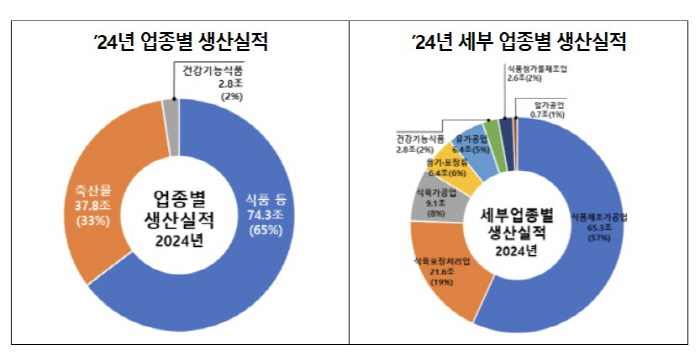Due to the trend of health flares, production of suger zero, plant-based, and high-protein foods surged last year
May 29, 2025
|
The Ministry of Food and Drug Safety and the Korea Food Safety Information Service (KFDA) announced that the total production performance of the domestic food industry in 2024 totaled 114.82 trillion won, up 5.8 percent from the previous year (108.4875 trillion won). They accounted for 4.5 percent of the gross domestic product (GDP) of 2549.12 trillion won and 16.8 percent of the gross domestic manufacturing industry (GDP) of 684.599.2 trillion won. By industry, food products (foods, food additives, container packaging, etc.) produced 74.292 trillion won (64.7%), livestock products 37.7714 trillion won (32.9%), and health functional foods 2.7618 trillion won (2.4%), and the ratio to total production performance was similar to last year. The export performance was USD 7,259.15 million, up 10% from the previous year (6.6 billion USD).
The main characteristics of the food industry's production performance in 2024 are, first of all, the health-pleasure trend that values health and pursues the enjoyment of meals, and the production performance of Sugar Zero products (20.1%↑), plant-based raw material-based products (5x↑), and high-protein products (24.0%↑) increased significantly compared to the previous year. Recently, it is analyzed that health management methods are changing from food consumption patterns such as diet control, which limits or avoids specific foods for personal health care, to a trend that values health and pursues the joy of eating together.
Livestock products showed a steady increase in low-sugar, low-salt, and low-fat products (21.3%↑), high-protein and low-fat products (7.3%↑), and non-antibiotic and animal welfare (three-year average of 11.9%↑) due to the spread of health and eco-friendly consumption. It is analyzed that the trend of low salt, mortgage, and low fat centered 'Low Food' has recently expanded in livestock products, and the demand for related products has steadily increased, especially among diet management consumers who value health. In addition, as interest in protein intake increases, the demand for products using low-fat high-protein parts such as chicken breast and pork front legs continues to increase, and it seems to be expanding to HMR such as lunch boxes and ham and processed meat.
Vitamin and inorganic products topped the list of health functional foods, beating red ginseng. This is attributed to the expansion of consumption of double formulations (refined + liquid integrated packaging) and the increase in export performance of vitamins and inorganic products. By functionality, sales of products that can help improve blood circulation and products that can help improve memory ranked first and second for four consecutive years. In addition, sales of products related to skin health and cognitive improvement increased 32.7% and 106.7% year-on-year, respectively, due to the spread of the well-aging trend of maintaining a healthy life.
This article was translated by Naver AI translator.














